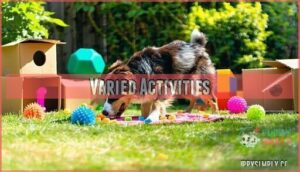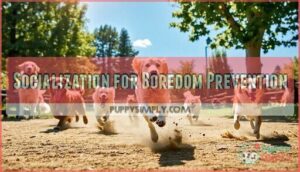This site is supported by our readers. We may earn a commission, at no cost to you, if you purchase through links.

This mental understimulation triggers destructive behaviors, excessive whining, pacing, and attention-seeking antics that’ll test your patience.
All breeds—from tiny Chihuahuas to brainy Border Collies—can fall victim to this restless state when their active minds aren’t properly engaged.
The fix involves combining daily exercise, interactive puzzle toys, and varied activities that tap into their natural instincts.
The transformation from destructive pest to content companion happens faster than you’d expect with the right approach.
Table Of Contents
- Key Takeaways
- Signs of Chronic Boredom in Dogs
- Recognizing Boredom in Dogs
- Physical Exercise for Mental Stimulation
- Socialization for Boredom Prevention
- Mental Stimulation With Food Puzzles
- Putting Your Dog to “Work
- Dealing With Excessive Barking
- Managing Your Dog’s Boredom
- Frequently Asked Questions (FAQs)
- Is your dog bored?
- Is boredom a problem in dogs?
- What causes boredom in dogs?
- How do you know if a dog is bored?
- How to prevent boredom in dogs?
- Is boredom causing your dog to get restless?
- What are the signs of chronic boredom in dogs?
- How can I tell if my dog is bored?
- What are some ways to relieve boredom in dogs?
- What are the dangers of boredom in dogs?
- Conclusion
Key Takeaways
- Recognize the warning signs early – Watch for destructive chewing, excessive barking, constant attention-seeking, and repetitive pacing patterns that signal your dog’s mind is not getting enough stimulation.
- Combine physical exercise with mental challenges – Daily walks are not enough; you will need to add puzzle toys, interactive feeding, nosework activities, and varied exercise routines to keep both body and brain engaged.
- Create structured "work" for your dog – High-energy breeds, especially, need purposeful activities like teaching new tricks, scent games, or agility training that channel their natural instincts productively.
- Do not assume breed immunity – All dogs, from Chihuahuas to Border Collies, can develop chronic boredom; you will need to tailor activities to your specific dog’s energy level and mental needs rather than relying on breed stereotypes.
Signs of Chronic Boredom in Dogs
When your dog can’t seem to settle down or constantly seeks your attention, they might be telling you something important about their mental state.
Your dog’s restless energy might be their way of asking for more mental engagement
Chronic boredom in dogs manifests through specific behavioral patterns that smart pet owners learn to recognize early, related to their mental state.
Destructive Behavior
When your dog transforms your favorite shoes into confetti or turns your backyard into a lunar landscape, you’re witnessing classic destructive behavior from chronic boredom.
Chewing habits, digging issues, and furniture damage signal unmet mental needs.
Household messes and excessive licking often follow, and these behaviors aren’t spite—they’re your dog’s creative attempt at self-entertainment when proper dog activities are missing.
Making boredom prevention essential is crucial, as it addresses the root cause of these issues, ensuring a more harmonious and clean environment for both you and your dog.
Constant Attention-Seeking
Your furry companion’s persistent whining behavior and clingy dogs tendencies reveal chronic boredom lurking beneath the surface.
When Fido develops shadow syndrome, following you everywhere while displaying constant neediness issues, it’s his way of communicating unmet mental stimulation needs.
This attentionseeking pattern intensifies when environmental enrichment lacks variety.
Recognizing these attention-seeking signals helps prevent escalating dog boredom through targeted engagement strategies and structured mental exercises, addressing the root cause of dog boredom.
Proximity Clinginess
Is your four-legged companion becoming your constant shadow? This clingy behavior often signals canine boredom rather than simple affection.
When dogs lack mental stimulation, they compensate by sticking close to their humans as entertainment.
Velcro dogs displaying this attention-seeking behavior typically exhibit:
- Shadow Behavior – Following you room to room without purpose
- Separation Anxiety – Distress when you’re briefly out of sight
- Persistent Positioning – Maintaining close physical proximity constantly
This clinginess stems from understimulation rather than love, indicating your dog needs structured activities and mental challenges to regain independence.
Pacing Patterns
Several behaviors signal that your dog’s experiencing chronic boredom, particularly when you observe repetitive pacing patterns.
This restless behavior often indicates pent-up energy and highlights significant boredom signs requiring immediate attention.
Understanding repetitive movement patterns helps identify underlying canine boredom:
- Restless Behavior – Dogs pace when lacking adequate mental stimulation and physical outlets
- Pacing Issues – Circular or back-and-forth movement patterns suggest dog anxiety from understimulation
- Dog Behavior Changes – Increased pacing frequency often precedes other destructive behavior manifestations
Harassing Other Dogs
Beyond pacing, you’ll notice a bored dog targeting housemates with persistent pestering.
This interdog conflict isn’t true canine aggression—it’s your pet seeking stimulation through annoying behaviors.
Watch for mounting, stealing toys, or blocking pathways.
These pack dynamics shifts indicate chronic boredom rather than social hierarchy disputes.
Your dog’s basically saying "entertain me" through disruptive actions.
Your furry friend’s destructive antics are their way of shouting I need entertainment!
Address this dog behavior pattern before it escalates into actual dog fights or creates lasting tension between pets, which can lead to lasting tension.
Over-Grooming
When other pets become targets of relentless pestering, your dog might redirect their boredom toward self-grooming. Excessive licking and fur chewing on paws or legs signals understimulation. This compulsive grooming habit creates skin irritation and hair loss, worsening without intervention.
Combat canine boredom with:
- Interactive puzzle feeders during meals
- Rotating chew toys to maintain novelty
- Short training sessions teaching new tricks
Mental stimulation prevents destructive behavior while giving restless paws healthier outlets than obsessive grooming, promoting a solution to understimulation.
Recognizing Boredom in Dogs
You might notice your dog’s boredom through several key behavioral changes that signal their need for more engagement.
These warning signs can appear regardless of your dog’s breed, size, or age, making recognition essential for every pet owner, as it allows them to identify and address their dog’s boredom.
Negative Behaviors
Your dog’s negative behaviors often signal chronic boredom rather than defiance.
Destructive chewing, excessive whining, and restless pacing indicate unmet mental needs.
These attention seeking behaviors stem from frustration, not malice.
- Destructive chewing of furniture or household items
- Excessive whining or vocalization throughout the day
- Restless pacing in repetitive patterns around the house
- Attention seeking behaviors like jumping or pawing
- Compulsive behaviors that weren’t present before
No Breed Exception
You can’t judge a book by its cover, and you can’t predict canine boredom by breed alone.
Chihuahuas suffer from chronic boredom just as much as Border Collies when their needs aren’t met.
Pet despair strikes universally—breed neutral research shows all dogs need mental stimulation and dog enrichment to prevent animal listlessness and dog fatigue.
| Breed Type | Boredom Signs | Risk Level |
|---|---|---|
| Working Breeds | Destructive chewing, digging | High |
| Toy Breeds | Excessive barking, clinginess | High |
| Companion Breeds | Pacing, attention-seeking | High |
| All Breeds | Canine ennui behaviors | Equal |
All dogs, regardless of breed, are at equal risk of experiencing boredom, which can lead to destructive behaviors if not addressed properly.
Evening Stimulation
Why does your dog transform into a furry tornado when you walk through the door?
Evening hyperactivity often signals daytime boredom. Your pup’s been saving energy all day, waiting for action.
Combat this with morning dog exercise, interactive games throughout the day, and calming exercises before bed.
Evening walks provide mental stimulation while nighttime play burns excess energy. Balance downtime activities with dog entertainment to prevent post-work chaos.
Behavioral Changes
Subtle shifts in your dog’s daily patterns often reveal chronic boredom beneath the surface.
Watch for these anxiety triggers and stress reactions that signal your pet needs more engagement:
- Increased vocalization – whining, barking, or howling without obvious cause
- Decreased appetite – showing less interest in meals or treats
- Lethargy – seeming unusually tired or unmotivated during normal activity times
- Changes in sleep habits – sleeping excessively or experiencing restless nights
- Irritability – snapping at family members or showing uncharacteristic grumpiness
These boredom cues can escalate into destructive behavior if ignored.
Importance of Affection
Strong emotional support forms the foundation of preventing dog boredom and building lasting canine bonding. Your dog’s affection needs extend beyond basic care, requiring consistent play interaction and genuine companionship to maintain proper mental stimulation.
Meaningful love signals include:
- Daily cuddle sessions that strengthen your bond
- Interactive games that boost dog engagement
- Praise and treats that increase dog motivation
- Quality time that prevents isolation-driven behaviors to foster a deeper bond.
Physical Exercise for Mental Stimulation
When your dog’s restless energy turns into destructive behavior, it’s time to recognize that physical exercise isn’t just about burning calories—it’s about engaging their mind.
The right combination of movement and mental challenge can transform a bored, anxious dog into a calm, satisfied companion, which is the ultimate goal of providing physical exercise.
Daily Exercise
Because every dog needs consistent physical activity to prevent destructive behaviors, daily exercise becomes your strongest weapon against canine boredom.
Regular walks and playtime sessions directly combat restlessness while supporting healthy weight management.
| Exercise Type | Frequency | Benefits |
|---|---|---|
| Structured walks | Daily | Builds routine, provides mental stimulation |
| Vigorous play sessions | 2-3 times weekly | Burns excess energy, strengthens bond |
| Dog sports activities | Weekly | Combines physical and mental challenges |
| Outdoor exploration | As needed | Satisfies natural curiosity, reduces anxiety |
| Interactive games | Daily | Enhances engagement, prevents destructive habits |
Your dog’s exercise needs vary by breed and age, but consistent physical activity remains non-negotiable for mental health.
The exercise types and frequencies outlined are crucial for preventing destructive behaviors and ensuring your dog leads a happy and balanced life.
Varied Activities
Beyond daily walks, your dog needs varied activities to stay mentally sharp.
Mix up routines with different Play Options and Interactive Toys to prevent habituation—the enemy of engagement. Creative Exercises challenge your dog’s problem-solving skills while Outdoor Games satisfy their natural instincts.
- Sensory Experiences: Introduce new scents, textures, and sounds through snuffle mats or bubble machines
- Interactive Games: Hide-and-seek, treasure hunts, and puzzle toys that dispense treats
- Environmental Changes: Rotate through different rooms, yards, or dog-friendly locations weekly
- Novel Challenges: DIY obstacle courses using household items like cardboard boxes and tunnels
This variety prevents your dog from getting stuck in boring routines and keeps their mind actively engaged. Engaging in dog physical exercise is essential for maintaining a healthy and happy dog.
Running or Biking
Running or biking with your dog creates the perfect combo of cardio benefits and mental stimulation.
These outdoor adventures break the monotony of regular walks while strengthening your bond.
Always prioritize bike safety with proper leashes and gradual conditioning.
- Cardio Benefits: Improved heart health and endurance
- Exercise Variety: Prevents workout boredom for both of you
- Mental Stimulation: New sights, sounds, and smells engage their mind
- Run Routine: Establishes consistent physical exercise for boredom prevention
Increased Focus
When you vary walking routes and include engaging scents, your dog’s mental clarity improves dramatically.
This mindful engagement transforms routine walks into powerful focus exercises that combat chronic boredom effectively.
- Route variety keeps your dog mentally alert and prevents predictable patterns
- Scent exploration provides natural brain games that enhance attention training
- Problem-solving activities during walks boost mental stimulation and overall mental health
Incorporating cluster training exercises can further enhance your dog’s physical and mental well-being.
Attention and Engagement
Playtime activities and interactive toys create powerful engagement strategies that transform routine dog exercise into mental stimulation opportunities.
You’ll find that incorporating puzzle feeders, hide-and-seek games, and basic dog training commands during play sessions keeps your pet’s attention focused while preventing destructive behaviors.
This dual approach addresses both physical energy and cognitive needs effectively, making it a valuable tool for dog owners to provide their pets with a well-rounded experience that includes mental stimulation.
Socialization for Boredom Prevention
Social interaction prevents boredom by engaging your dog’s natural pack instincts and providing mental stimulation through communication with other dogs and humans.
Regular playdates, visits to dog parks, and controlled meetups with well-socialized dogs create opportunities for natural behaviors that tire your dog both mentally and physically, which can be considered as mental stimulation.
Importance of Socialization
Socialization creates the foundation for your dog’s mental well-being, acting like a key that opens their potential for happiness.
Dogs with proper social bonds show 60% less anxiety-related behaviors compared to isolated pets.
Regular dog interactions and human connection through structured activities prevent destructive tendencies while building confidence.
Play therapy sessions and canine companionship opportunities provide essential mental stimulation that combats chronic boredom.
Key socialization benefits include:
- Interactive games that strengthen communication skills and reduce fearfulness
- Dog training classes that offer controlled environments for safe social development
- Dog behavior improvements through exposure to varied stimuli and experiences
Interaction With Humans
Human interaction forms the foundation of your dog’s social development and mental well-being.
Regular owner engagement through dog training sessions, interactive play, and social interactions provides mental stimulation while strengthening human bonding.
Play therapy activities like fetch, tug-of-war, and teaching new commands create meaningful connections that prevent boredom and behavioral issues in your furry companion, which is crucial for their mental well-being and social development, and can be achieved through regular engagement.
Puppyhood Socialization
Those first few months of puppyhood shape your dog’s ability to handle new experiences without becoming anxious or destructive later.
Dogs who missed proper Early Socialization during Puppy Development often struggle with boredom because they lack the Social Skills needed for confident exploration.
Effective dog training during this window builds mental resilience that prevents future behavioral issues.
Proper socialization techniques involve understanding critical socialization periods to raise a well-adjusted dog.
- Proper puppyhood socialization creates confident dogs who engage actively with their environment rather than developing destructive boredom behaviors
Play Dates
Dog interactions through structured play dates offer essential social skills development and mental stimulation.
You’ll want to match canine companions by size, energy level, and play style for successful sessions.
Schedule regular fun activities with compatible dogs to prevent boredom while building confidence.
These socialization opportunities provide natural exercise and teach appropriate behaviors through interactive play experiences.
Alternatives
When play dates aren’t possible, dog parks and doggie daycare offer excellent environmental enrichment opportunities for social pups.
These alternatives provide sensory stimulation through new sights, sounds, and smells while encouraging natural behaviors.
Consider these creative outlets for mental stimulation:
- Puzzle toys that challenge problem-solving skills
- Interactive toys like treat-dispensing balls for engagement
- Training sessions teaching new commands or tricks
- Nosework activities tapping into natural scenting abilities
- Agility courses combining physical and mental challenges
- Calming aids like snuffle mats for relaxation
- Novel activities rotating dog toys to maintain interest
Mental Stimulation With Food Puzzles
Transforming your dog’s mealtime into a mental workout can substantially reduce chronic boredom behaviors.
Food puzzles and interactive feeding methods challenge your dog’s problem-solving skills while satisfying their natural foraging instincts, which can help to make mealtime more engaging and reduce boredom.
Change Feeding Routine
Transforming mealtime into Interactive Feeding sessions combats dog boredom effectively. Instead of simply filling bowls, create Food Puzzles by scattering kibble across rooms or hiding treats in cardboard boxes.
Meal Variety prevents monotony—rotate proteins weekly and add safe vegetables like carrots. This approach triggers natural foraging instincts while promoting Slow Eating patterns that support digestive health.
Providing mental stimulation through dog boredom solutions can also help prevent destructive behaviors.
| Method | Benefits |
|---|---|
| Scatter feeding | Activates foraging instincts, extends mealtime |
| Hidden meals | Reduces destructive behavior, builds confidence |
| Protein rotation | Prevents food rejection, adds nutritional value |
| Timed feeding | Creates anticipation, maintains routine structure |
Puzzle Toys
Beyond basic kibble meals, puzzle feeders transform your dog’s dining experience into engaging brain games.
These interactive toys challenge your pet’s problem-solving skills while preventing dog boredom through mental stimulation.
Choose durable, dishwasher-safe options made from non-toxic materials that match your dog’s skill level.
Dog puzzles provide boredom prevention by making mealtime an exciting mental workout rather than mindless consumption.
Using Dog Puzzle toys can help reduce boredom and stress in dogs, and provide an engaging experience.
Interactive Bowls
Interactive bowls transform mealtime into engaging Food Puzzles that combat dog boredom effectively.
These specialized feeding tools feature ridges, mazes, or obstacles that slow eating while providing mental stimulation.
You’ll find Bowl Variety ranging from simple slow-feeders to complex puzzle designs.
Feeding Games created by interactive bowls encourage natural foraging behaviors, turning routine meals into enrichment activities that boost Dog Engagement substantially.
Mental and Physical Engagement
Food puzzles transform mealtime into engaging play therapy sessions that combat dog boredom effectively.
These Interactive Toys challenge your pup’s problem-solving abilities while encouraging Physical Activities through movement and manipulation.
Mental Games like puzzle feeders provide essential mental stimulation that tired brains need.
Here’s how food puzzles enhance your dog’s mental health:
- Mental stimulation – Your dog’s brain works overtime solving feeding challenges
- Exercise Routines – Physical movement becomes part of every meal
- Behavioral improvement – Destructive habits decrease when minds stay busy
- Confidence building – Successfully solving puzzles boosts your dog’s self-esteem
Tailored to Dog’s Needs
Dog personalization matters when selecting food puzzles for mental stimulation and boredom prevention.
Consider your dog’s breed requirements and energy levels when choosing interactive toys. High-energy breeds need complex mental challenges, while seniors benefit from simpler enrichment activities.
Match puzzle difficulty to your dog’s problem-solving abilities. Customized play prevents frustration and maintains engagement, making each feeding session an effective mental workout that addresses individual needs.
Putting Your Dog to “Work
High-energy dogs thrive when they’ve a specific job to do, channeling their natural drive into productive activities that prevent destructive behaviors.
You can transform your dog’s excess energy into focused work through nosework training, teaching complex behaviors, or creating exercise routines that feel purposeful rather than repetitive, which helps in preventing destructive behaviors by providing a sense of purposeful activity.
High-Energy Dogs
High energy dogs need more than basic walks to stay satisfied and prevent destructive behavior.
These breeds require structured activities that challenge both their bodies and minds simultaneously.
Dog sports like agility, flyball, or dock diving provide excellent outlets for their abundant energy levels while offering mental challenges.
Regular play activities such as fetch, tug-of-war, and interactive games help meet their exercise needs.
Without proper mental stimulation and physical outlets, high energy dogs often develop problematic behaviors including excessive barking, chewing, and hyperactivity.
High energy dogs that do not receive adequate physical and mental exercise may exhibit destructive behavior.
Nosework
Tapping into your dog’s incredible olfactory system transforms boredom into brain-boosting adventures.
Nosework activates up to 40 times more brain area than visual tasks, making it powerfully effective for mental stimulation.
Your dog’s nose becomes their greatest entertainment tool through these structured activities:
- Start with basic scent games by hiding treats around your home for discovery
- Introduce snuffle mats and olfactory exercises that encourage natural foraging behaviors
- Progress to canine tracking activities using essential oils like birch or anise
- Practice nose training sessions lasting 10-15 minutes to maintain ideal focus
Professional nosework classes offer structured progression through AKC Scent Work programs.
These activities reduce destructive behaviors by 40% while lowering stress indicators substantially.
Scent work satisfies your dog’s instinctual needs while providing purposeful mental challenges that combat chronic boredom effectively.
To further enhance your dog’s nosework experience, consider utilizing Nosework Kits to create engaging scent games.
Teaching New Behaviors
Teaching your dog new behaviors transforms mental energy into focused learning sessions that combat boredom effectively. Clicker Training marks precise moments when your pup nails a behavior, making Behavior Modification crystal clear.
Start with simple Obedience Lessons like "sit" or "stay," then progress to advanced Trick Learning such as rolling over or playing dead.
| Training Type | Time Investment | Mental Challenge Level |
|---|---|---|
| Basic Commands | 5-10 minutes | Low to Medium |
| Complex Tricks | 15-20 minutes | Medium to High |
| Agility Coaching | 20-30 minutes | High |
Regular training sessions provide structured mental stimulation while addressing problematic dog behavior rooted in boredom.
You’ll notice your dog’s focus sharpens as they anticipate each learning opportunity.
These sessions don’t replace physical exercise but complement it perfectly, creating a tired, satisfied pup who’s less likely to chew your favorite shoes.
Exercise as Work
Transform your energetic canine into a focused athlete through structured Canine Athletics and Dog Sports.
Job Training creates purpose while exercise routines channel excess energy productively.
Running partnerships, agility courses, and physical labor activities provide essential mental stimulation alongside physical exercise.
These structured programs prevent dog boredom more effectively than casual walks, giving your companion meaningful work that satisfies their natural drive for purposeful activity.
They offer a way to engage your dog in physical exercise and mental stimulation, making them a great alternative to casual walks.
Preventing Excess Energy
Dogs with excess energy need structured Physical Outlets to prevent destructive behaviors.
Exercise Routines combined with mental stimulation create effective Energy Burners that channel your dog’s drive productively.
Consider these proven strategies:
- Daily physical exercise sessions lasting 30-60 minutes
- Interactive toys that challenge problem-solving abilities
- Nosework games using scent identification activities
- Agility training courses in your backyard
- Dog play dates with compatible companions
- Calming Techniques like structured cool-down periods
- Play Therapy through supervised fetch sessions
- Obedience classes for mental engagement
- Varied walking routes exploring new environments
Dealing With Excessive Barking
When your dog’s barking becomes excessive and persistent, it’s often their way of telling you they’re mentally understimulated and need more engagement.
This vocal behavior typically stems from boredom, loneliness, frustration, or territorial instincts that haven’t been properly channeled through appropriate activities, often leading to a state of being mentally understimulated.
Excessive Barking as an Indicator
When your bored dog starts barking non-stop, they’re basically shouting "I need something to do!"
Excessive barking often signals chronic boredom, with attention seeking behavior becoming the primary barking trigger.
Different breeds show breed predisposition to anxiety barking, while noise sensitivity can amplify this destructive behavior.
Your dog’s persistent vocalizations indicate unmet mental stimulation needs requiring immediate intervention.
Boredom, Loneliness, and Frustration
When anxiety and social isolation combine, your bored dog might bark excessively as their stress response kicks into overdrive.
Pet boredom creates a cycle where owner absence triggers emotional needs that manifest through constant vocalization.
- Increase mental stimulation through puzzle toys and training sessions
- Address social isolation with regular playdates or doggy daycare visits
- Establish consistent routines to reduce separation anxiety triggers
- Provide comfort items like favorite toys during alone time
These behavioral consequences signal your dog’s desperate attempt to cope with understimulation.
Territorial Behavior
Why does your dog guard certain areas like they’re protecting Fort Knox? Territorial barking stems from your dog’s instinct to defend their space, especially when a bored dog lacks proper mental stimulation.
This boundary setting behavior intensifies when dogs feel their territory is threatened.
- Resource guarding around food bowls, toys, or favorite sleeping spots
- Space control at doorways, windows, or yard perimeters where they monitor activity
- Dominance displays through aggressive posturing when strangers approach their domain
To address territorial barking, you must understand and apply effective bark control methods.
Separation Anxiety
Beyond territorial behavior, separation anxiety creates another layer of Dog Distress when Owner Absence occurs.
Unlike simple boredom, Separation Phobia involves genuine panic that triggers intense Stress Signals. Your dog’s anxiety manifests through predictable patterns that worsen without proper mental stimulation and consistent dog wellness routines.
- Excessive barking that starts immediately when you leave and continues throughout your absence
- Pacing, whining, or destructive behavior focused near doors and windows where they last saw you
- Destroying personal items that carry your scent, like shoes or clothing
- Becoming unusually clingy when you’re home, following you from room to room as Anxiety Triggers build
Managing Your Dog’s Boredom
Successfully managing your dog’s chronic boredom requires a systematic approach that addresses their individual needs and behavioral patterns.
By combining targeted physical exercise, mental stimulation, and consistent monitoring, you’ll create an environment that prevents destructive behaviors while promoting your dog’s overall well-being.
Observing Behavioral Patterns
Pattern recognition starts with understanding your dog’s body language and canine cues throughout the day.
Watch for these behavioral signs that signal chronic boredom:
- Whining or vocalizations without obvious triggers
- Repetitive pacing in specific room patterns
- Excessive licking of paws or furniture surfaces
- Scratching at doors, walls, or themselves frequently
- Changes in eating schedules or sleeping locations
Observation techniques involve noting when these behaviors occur most often, helping you identify your dog’s specific boredom triggers and peak restless periods, which is crucial for addressing chronic boredom and developing effective strategies to prevent restless periods.
Tailoring Activities to Breed
Once you’ve identified your dog’s patterns, matching activities to their breed becomes your next priority.
Different breeds pack unique energy levels and exercise needs that demand breed-specific solutions.
- Energy Levels: High-drive breeds like Border Collies need intensive mental challenges, while lap dogs prefer gentler engagement
- Exercise Needs: Working breeds thrive with job-like tasks, sporting breeds crave retrieval games, and toy breeds enjoy interactive toys indoors
- Tailored Play: Canine personalization means providing breed-specific activities that satisfy natural instincts and prevent destructive behaviors
Incorporating Mental Stimulation
Mental stimulation transforms your restless pup into a contented companion through engaging activities that challenge their cognitive abilities.
These exercises provide essential mental enrichment that complements physical activity for thorough boredom prevention.
Effective mental stimulation options include:
- Puzzle Toys – Challenge problem-solving skills with treat-dispensing feeders
- Brain Games – Hide-and-seek and shell games boost concentration
- Scent Work – Scatter feeding taps into natural foraging instincts
- Interactive Play – Rotating toys maintains novelty and engagement
- Mental Exercises – Basic obedience training provides structure and stimulation
- Food puzzles – Transform mealtime into engaging problem-solving sessions
- Interactive toys – Keep minds busy with treat-dispensing balls
- Training sessions – Teach new tricks for ongoing mental challenges
- Snuffle mats – Encourage natural sniffing behaviors
- DIY activities – Create homemade puzzles using household items
By incorporating positive reinforcement techniques into mental stimulation, you can create a more engaging and effective training experience for your dog.
Seeking Professional Guidance
When your dog’s boredom reaches chronic levels, seeking help from trained professionals can transform your situation dramatically. Trainer Consultation provides specialized insight into your dog’s unique behavioral patterns and energy requirements.
Professional coaching offers several key advantages for addressing destructive behavior:
- Veterinary Advice helps rule out underlying medical conditions that might contribute to restlessness or anxiety
- Behavioral Therapy techniques target root causes rather than just symptoms of chronic boredom
- Expert Opinion creates customized mental stimulation programs based on your dog’s breed and temperament
- Professional Coaching teaches you effective techniques for maintaining engagement long-term
Board-certified veterinary behaviorists achieve 67% success rates in reducing destructive habits through evidence-based approaches. They’ll assess your dog’s physical needs, environmental factors, and behavioral triggers to develop thorough solutions.
Early intervention proves vital—studies show 72% fewer severe behavioral cases when addressed promptly. Professional guidance strengthens your bond with your dog while providing sustainable strategies for dog health and overall well-being. Investment in expert support delivers lasting results for both you and your companion.
Monitoring Changes in Behavior
After professional guidance, behavior tracking becomes your roadmap to success.
Watch for these key indicators that reveal your dog’s mental state:
- Mood swings between restlessness and lethargy
- Energy levels that spike unexpectedly throughout the day
- Body language showing stress signs like panting or pacing
- Destructive behavior patterns that signal inadequate mental stimulation
Consistent monitoring helps you catch boredom before anxiety develops.
Frequently Asked Questions (FAQs)
Is your dog bored?
Watch for destructive chewing, excessive barking, digging, pacing, or clingy behavior when you’re home. These behaviors signal your dog’s mind isn’t getting enough stimulation and they’re creating their own entertainment.
Is boredom a problem in dogs?
Like Pandora’s box releasing chaos, canine boredom creates destructive havoc in your home.
Yes, boredom’s a significant problem causing excessive barking, chewing, digging, and anxiety-driven behaviors that strain your relationship with your dog.
What causes boredom in dogs?
Insufficient exercise, lack of mental challenges, repetitive routines, and inadequate social interaction create boredom in dogs.
You’ll notice your pup becomes restless when they don’t receive enough physical activity or engaging experiences to stimulate their minds.
How do you know if a dog is bored?
Your dog becomes a restless prisoner in their own home, pacing endlessly while seeking escape from invisible chains of monotony.
You’ll notice destructive chewing, excessive barking, attention-seeking behaviors, and repetitive pacing patterns signaling their need for stimulation.
How to prevent boredom in dogs?
You’ll prevent dog boredom by providing daily physical exercise, rotating interactive puzzle toys, teaching new tricks regularly, and creating mental challenges like hide-and-seek or scent games throughout their day.
Is boredom causing your dog to get restless?
Yes, restlessness is a telltale sign your dog’s bored.
You’ll see pacing, inability to settle, and constant movement as they search for stimulation.
Increase exercise, add puzzle toys, and provide mental challenges to help them relax.
What are the signs of chronic boredom in dogs?
Chronic boredom manifests through destructive chewing, excessive barking, digging, attention-seeking behaviors like whining or nudging, restlessness, pacing, clinginess, escape attempts, and repetitive self-soothing behaviors like excessive licking.
How can I tell if my dog is bored?
Look for destructive behaviors like chewing furniture, excessive barking, or digging. You’ll notice attention-seeking through whining, nudging, or following you everywhere. Pacing, restlessness, and escape attempts also signal boredom.
What are some ways to relieve boredom in dogs?
Need to break your dog’s boredom cycle?
Combine daily physical exercise with mental challenges like puzzle toys, training sessions, and interactive games.
Rotate toys regularly, try snuffle mats for scent work, and vary walking routes to keep things fresh and engaging, including providing mental challenges.
What are the dangers of boredom in dogs?
Bored dogs face serious health risks including obesity from sedentary behavior, joint problems from lack of exercise.
Chronic stress affecting overall well-being, and strained relationships with owners due to destructive behaviors are also significant concerns, with sedentary behavior being a key factor.
Conclusion
Congratulations—you’ve successfully trained your dog to become a four-legged tornado of destruction, turning your home into their personal amusement park.
But seriously, addressing a dog suffering from chronic boredom isn’t rocket science.
You’ve learned to spot the warning signs and implement practical solutions through exercise, mental stimulation, and proper socialization.
With consistency and patience, you’ll transform your restless companion into a well-balanced, content dog who saves their energy for appropriate activities.
- https://amazinganimalminds.com/the-misunderstood-link-between-impulsivity-and-boredom-in-dogs-how-to-help-reactive-dogs-feel-better/
- https://pmc.ncbi.nlm.nih.gov/articles/PMC6680786/
- https://www.alphapaws.com/common-symptoms-and-solutions-for-dog-boredom/
- https://olk9iowa.com/does-your-dog-get-bored-signs-fix/
- https://www.independent.co.uk/news/science/lonely-dogs-brains-shrinking-bestial-boredom-cattle-zoo-animals-animal-welfare-lecturer-charlotte-burn-the-royal-veterinary-college-animal-behaviour-a7903146.html





















